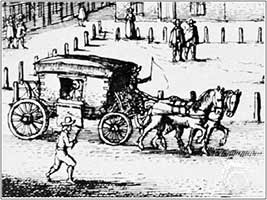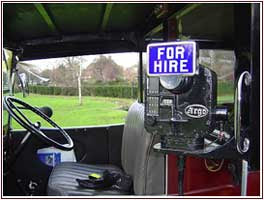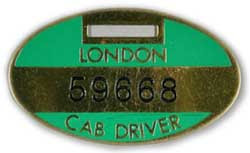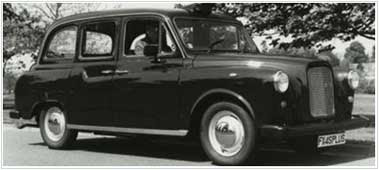
Si decimos "taxi" y "Londres", ¿quién no imagina al instante este famoso icono inglés: el taxi negro?
(If we say "taxi" and "London", who does not instantly picture this famous English icon: the black cab?)
De hecho, son los únicos que pueden recoger pasajeros en las calles, ya que el otro tipo de "taxis", los 'mini taxis' deben ser alquilados previamente por teléfono o en una de sus oficinas.
(In fact, they are the only ones which can pick up passengers on the street, as the other type of "taxis", minicabs, must be booked in advance by phone or in any of their offices.)
 (Hackney coach about 1646 - Engraving by W. Hollar. In Encyclopædia Britannica. )
(Hackney coach about 1646 - Engraving by W. Hollar. In Encyclopædia Britannica. )En 1635, la Ley sobre coches de alquiler Hackney fue la primera legislación sobre taxis en Londres. Parece ser que el nombre 'Hackney' deriva de la raza de caballos, 'haquenée', que tiraban de los coches. En 1625 ya había unos 20 coches de alquiler. Hacia 1654 eran 300 con licencia en Londres y sus alrededores, y hacia 1832, unos 1.200. Hoy día, son unos 24.000 –en Zaragoza, mi ciudad, hay unos 1.800 taxis. El término 'coche Hackney' sigue siendo el término oficial para referirse a los taxis londinenses.
(In 1635, the Hackney Carriage Act was the first taxi cab legislation in London. It seems that the name 'Hackney' comes from the breed of the horse, 'haquenée', which drew carriages. In 1625 there were already about 20 hackney coaches plying for hire. By 1654 there were 300 licensed hackney coaches allowed in London and its environs, and by 1832 there were about 1,200. Today they are about 24,000 –in Zaragoza, my city, there are about 1,800 taxi cabs. 'Hackney carriage' is still the official term used to describe London taxis.)
 Foto Foto |  Foto Foto |
Cuando se empezaron a utilizar los cabriolés, coches de dos ruedas franceses, a principios del siglo XIX, se empezaron a conocer como "cabs".
Y cuando Wilhem Bruhn inventa el taxímetro en 1891, nace el término de 'taxi'. Como su nombre indica (del francés taxe, 'precio', y del griego metron, 'medida'), el taxímetro mide la distancia recorrida y el tiempo transcurrido en el viaje, calculando la tarifa precisa que se ha de cobrar. Por cierto esta tarifa seguía siendo fijada por el Parlamento hasta el año 2000 cuando la Oficina de Transporte Para Londres empezó a controlar las leyes que rigen el negocio de los taxis londinenses.)
(When the drivers began using lighter cabriolets, two-wheeled vehicles from France, at the beginning of the 19th Century, they became known as 'cabs'. Likewise, when Wilhelm Bruhn invented the taximeter in 1891, the term 'taxi' was born. As its name says (from French taxe, 'price, and Greek metron, 'measure')the taximeter measures the distance travelled and time taken of all journeys, allowing an accurate fare to be charged. By the way, the fares were still set by Parliament as they have always been until 2000 when Transport For London took in charge the laws governing London's taxi trade.)
Todos los taxis londinenses tienen que aprobar las "Condiciones de Capacidad". Esto significa que tienen que tener un círculo de giro de 7,6 m (25 pies) —pueden dar la vuelta completa para salir de una fila central en ese espacio; el compartimento de los pasajeros tiene que ser lo suficientemente alto para que se pueda ir cómodamente sentado con un sombrero de copa en la cabeza y, la altura del nivel del suelo no puede ser superior a 38 cm (15 pulgadas). También deben ser accesibles para sillas de ruedas.
(All black taxis have to pass the 'Conditions of Fitness'. This means that they must have a 25 ft (7.6 m) turning circle so the cab can U-turn off a central rank, that the passenger compartment must be high enough that a top-hatted passenger can sit in comfort, and that the entrance must not be above 15 in (38 cm) from ground level. Cabs must also all be wheelchair accessible.)
 Foto Foto |  |
Hoy día, los aspirantes todavía tienen que superar estrictos exámenes antes de poder convertirse en taxistas en Londres. Deben ser mayores de 21 años y tener un minucioso conocimiento de la parte de Londres en la que quieren trabajar: a esto se le llama "El Conocimiento".
(Today, applicants still have to pass strict tests before they could become London taxi drivers. Drivers must be over 21 and have a thorough knowledge of London: this is 'The Knowledge'.)
"El Conocimiento de Londres" fue instituido en 1851 por Sir Richard Mayne, jefe de la policía metropolitana de Londres de 1829 a 1868, después de que algunos clientes se quejaran de que los taxistas no sabían adonde iban. Aprobar El Conocimiento supone recordar al detalle 320 rutas (o "carreras") con las 25.000 calles existentes dentro del radio de 6 millas (10 km) a partir de la estación de Charing Cross. Deben saber también el emplazamiento de clubes, hospitales, hoteles, estaciones, parques, teatros, restaurantes, escuelas y conservatorios, edificios gubernamentales y lugares de culto: cualquier punto conocido en el recorrido más corto de un punto a otro.
(The 'Knowledge of London' was introduced in 1851 by Sir Richard Mayne, head of the London metropolitan Police from 1829 to 1868, after some customers complained that cab drivers did not know where they were going. Passing the Knowledge involves detailed recall of 320 routes (or "runs") with the 25,000 streets within a six-mile radius of Charing Cross station. The locations of clubs, hospitals, hotels, railway stations, parks, theatres, restaurants, colleges, government buildings and places of worship are also required: any landmark along the shortest journey.)
Se puede tardar entre dos y cuatro años en aprobar el examen. De hecho, sólo tres de cada diez personas que empiezan el "Conocimiento" acaban y reciben la insignia verde que los acredita como conductores de un taxi londinense.
(It can take between two and four years to pass the test. In fact, only three out of ten people who begin the Knowledge finish and receive the green badge which entitles them to drive a London black cab.)
Aunque los taxis de Londres son tradicionalmente negros, hoy día a menudo exhiben coloridas publicidades en su carrocería.
(Although London's taxis are traditionally black, nowadays they often display colourful adverts on their bodywork.)
 Foto Foto | |
 Foto Foto |  Foto Foto |
Así que la próxima vez que cojáis un taxi en Londres, disfrutad de estar en tan expertas manos y ser parte de tan antigua tradición.
(So the next time you take a taxi in London, enjoy being in such capable hands and taking part of such an ancient tradition.)















No hay comentarios :
Publicar un comentario